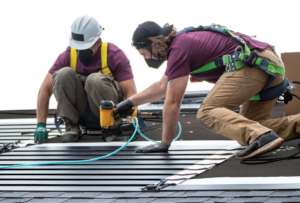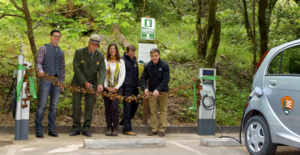In This Issue
- Flanigan’s Eco-Logic: Storage is the Answer
- Lithium-Ion Battery Recycling
- Big American Solar in Indiana
- From Coal Mining to Pumped Hydro Storage
- GAF Energy’s Solar Roof Shingles
- Ubiquitous Energy’s Solar Windows
- Adopt a Charger
- EV Hubs and Battery Swap Stations
- The NetPositive Podcast Updates

Flanigan’s Eco-Logic: Storage is the Answer
This op-ed is about accelerating solar. Given the climate emergency at hand, and the abundance of free power from above… of course we need to tap solar for our short-term and long-term benefit. The CPUC’s Proposed Decision on net energy metering – see EcoNet News Volume 23 Issue #12 – will retard solar. Is that what we want? No, of course not. This op-ed is about accelerating solar… now smartly with storage.
Without question, here in California we need less power production in the middle of the day. We’re the leading state for distributed solar and we’re awash in mid-day solar thanks to the State’s 1.3 million rooftop solar systems with an aggregate capacity of 10,000 MW. We’ve learned about the duck curve and the perverse effect of so much solar on the grid. When the sun is shining, we have too much of it. Not just rooftop solar… all solar! Huge solar farms in the desert are a big piece of this equation. The solar phenomenon has even shifted our peak period. By 2019, SEIA found that California has 24,700 MW of solar. Much from 771 utility scale plants with a capacity of 14,000 MW.
Let’s recognize the great value that California’s solar policies – the California Solar Initiative (CSI) and Net Energy Metering (NEM) – have provided to California and perhaps one could say the global solar market. The CSI provided a billion dollars of incentives for early adopters to cut the upfront costs of solar. NEM is a major incentive that allows solar to provide great, ongoing financial value, with complete utility back-up. This spawned a new industry of very local jobs. These policies ultimately led to a mandate for all new homes and buildings to be net zero.
And now, yes, solar policy needs to be tweaked. It is certainly time for an upgrade. We now need policies in California and other states that optimize on the benefits and, yes, that minimize the current fault of promoting too much power sloshing onto the grid during the day.
Here’s the deal: If you generate solar on your rooftop during the day right now, it is providing very little value to the grid. You may even be creating a negative value for utilities that have to pay to dump excess power. And you know what makes the situation even worse? Utilities are forced to credit the producer for this near valueless power, and to then give it back to the customer during peak hours at no charge. NEM has understandably become a painful construct for utilities and utility ratepayers.
So what to do? Modify the NEM incentive. Don’t remove it and add penalties. Here’s my proposed plan: You only get to net energy meter if you install solar + storage. Instead of having excess power that has to be dumped, the excess is stored for later use.

California – and later other states – needs to design programs such that utilities can call on the storage when needed for export to the grid. This is really valuable, turning a losing venture into a collaborative success. Now the solar system owner – the great volunteer willing to invest in clean energy – can do so in a way that provides mutual benefit to the consumer, and the grid. The key is requiring storage. Now we can hold that solar power and match it perfectly with our consumption.
Solar has been a rich man’s game. Only the rich can buy, monetize tax credits later, and watch their bill drop to near zero. There has been no equity in this equation and efforts to provide equity are costly and from a resource standpoint, largely ineffective. What to do? I advocate well-designed community solar + storage programs. Build in the desert, tap the economies of scale, and allow all ratepayers the option to invest in solar + storage for economic and environmental reasons.
Two things to amplify: First, and grossly unlike California’s community solar program, the program design has to be simple and valuable. EcoMotion has studied the State’s flawed program extensively. There are much more effective models. Second, the solar has to be paired with storage. It’s the same as rooftop solar: We need to tap the solar resource and to store the valuable carbon free energy for later use.
Longer term, the discussion about solar + storage and creating greater resilience through a network of microgrids, begs a new tariff. Sure, if you invest in solar + storage and can provide resilience to the grid… you deserve to be rewarded. This could happen through a new discounted rate structure for storage accounts (that can export power to the grid) and energy resilience accounts (those that can island). The volunteers that build these systems are providing benefits for themselves and for the grid. Thus rates need to reflect this value.
See how far we are from the Proposed Decision? It aims to make solar much less attractive to the volunteers. Instead, I want to make solar + storage much more attractive. Let’s make it hugely beneficial for volunteers. This is what we need as a society… a logical path forward to promote solar, to accelerate solar… not to penalize a valuable resource as the California Public Utilities Commission has suggested.





 GAF Energy has reportedly installed several thousand integrated solar roofs. That’s more than Tesla Energy roof tiles despite its “ambitious promises.” GAF Energy President Martin DeBono believes his company’s photovoltaic roof shingle positions GAF well to solarize millions of residential roofs. He believes that technology is going to change roofing, that there will be disruption. He compares solar shingles to traditional mounting of solar panels, “solar panels installed on racking secured by drilling through the roof and trying to hit a rafter.”
GAF Energy has reportedly installed several thousand integrated solar roofs. That’s more than Tesla Energy roof tiles despite its “ambitious promises.” GAF Energy President Martin DeBono believes his company’s photovoltaic roof shingle positions GAF well to solarize millions of residential roofs. He believes that technology is going to change roofing, that there will be disruption. He compares solar shingles to traditional mounting of solar panels, “solar panels installed on racking secured by drilling through the roof and trying to hit a rafter.”


 Oil companies are getting into EV charging in a big way. Shell, the oil giant, has one of the world’s largest networks of fuel stations with over 46,000 retail sites for gasoline and diesel. It also operates a growing network of 8,000 electric charging points and has plans to operate 500,000 charge points by 2025, and 2.5 million by 2030.
Oil companies are getting into EV charging in a big way. Shell, the oil giant, has one of the world’s largest networks of fuel stations with over 46,000 retail sites for gasoline and diesel. It also operates a growing network of 8,000 electric charging points and has plans to operate 500,000 charge points by 2025, and 2.5 million by 2030.
